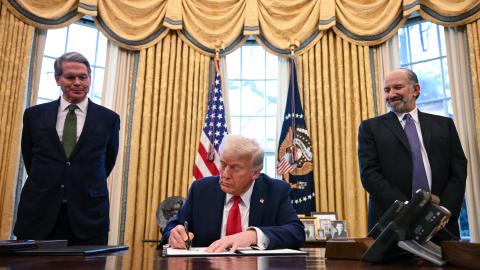Ten prominent policy experts have released a new Obamacare alternative published by the American Enterprise Institute. The most important part of any Obamacare alternative is how it would address the longstanding inequality in the tax code (which favors employer-based insurance over individually purchased insurance) that's at the root of our nation's (pre-Obamacare) health-care woes. It's therefore encouraging to see that this is another prominent proposal—along with the one that Ed Gillespie almost rode to victory in the Virginia senate race, and the one introduced by Tom Price in the House (and cosponsored by Jeb Hensarling, Trey Gowdy, and 77 others)—that has adopted the tax treatment proposed by “An Alternative to Obamacare” (originally released by the 2017 Project
"An Alternative to Obamacare," and all of the proposals based upon it, would leave the tax treatment of the typical employer-based insurance plan alone, while closing a tax loophole at the high end. These proposals would do so by capping the tax break for employer-based insurance at $20,000 for a family plan an $8,000 for an individual plan. (A family with, say, a $23,000 family plan would still get their full tax break on the first $20,000, just not on the last $3,000.) These proposals would likewise offer a simple, refundable, non-income-tested tax credit for those in the individual market—thereby providing a long-overdue tax break to those who buy health insurance on their own—in the following amounts: $1,200 for those under the age of 35; $2,100 for those between 35 and 50; $3,000 for those 50 and over; and $900 per child. And they would offer a one-time, $1,000-per-person tax credit to those who have or who open a health savings account (HSA).
(The AEI-published proposal leaves a bit of rhetorical wiggle-room on some of these points, but the version of it that was scored includes all of these provisions. The plan also proposes Paul Ryan-style Medicare premium-support (a crucial reform), Medicaid reforms, and other miscellaneous health-care reforms.)
This growing consensus—on maximizing the chances of repeal by not disrupting the employer-based market; offering simple, non-income-based tax credits with three simple age-bands; and promoting the use of HSAs—is welcome. But at the same time, there is a debate emerging on the right or center-right between those who want to spend all or most of the Obamacare money, and those who don't. And there is a corresponding debate emerging between those who want to have the government deal directly with insurance companies on people's behalf, even in cases where people haven't asked for this to happen, and those who think American citizens should be in control of their own money, decisions, and bill-paying, rather than having such things handled for them by benevolent technocrats.
The AEI-published proposal is on the pro-spending, pro-technocratic side of this emerging rift. It would make tax credits advanceable (available in advance of tax time). This almost certainly means making them not really tax credits—tax credits should cut people's taxes—but direct subsidies to insurance companies, like the ones Obamacare provides. (There is a way to make an advanceable tax credit genuinely a tax credit, but there's no evidence that this newly released plan would adopt such an approach.)
Furthermore, the AEI-published proposal would encourage state governments to "auto-enroll" Americans in insurance plans they haven't chosen and haven't given any indication they want. In the proposal's words, this would involve "assigning persons who are eligible for the tax credits but have failed to pick an insurance policy" to a policy of the government's choice. (The person's premiums would be paid through a direct taxpayer-funded subsidy to the insurance company.)
In addition to being paternalistic, this "auto-enroll" provision could be politically toxic. In some ways, it would go beyond even Obamacare's despised individual mandate. Obamacare compels Americans to buy insurance. But even it doesn't "assign" people to insurance that they've "failed" to buy.
Moreover, auto-enroll" would cost a fortune. The nonpartisan Center for Health and Economy tax credits would save $502 billion versus Obamacare's premium subsidies to insurance companies over eight years, while the latter's would cost $550 billion more than Obamacare's over eight years. A similar margin is reflected in the overall scoring (which includes, among other things, the effects of rolling back Obamacare's Medicaid expansion): "An Alternative to Obamacare" would reduce spending by $1.13 trillion versus Obamacare over eight years (from 2016 through 2023)—so about $1.4 trillion over a full decade—while the AEI-published alternative would reduce spending by just $188 billion over eight years (from 2018 through 2025), or about $235 billion over a decade—only about one-sixth as much.
Finally, the new proposal wouldn't repeal all of Obamacare. It would allow people to keep their Obamacare subsidies for as long as they'd like to keep their Obamacare plans. It would allow people involved in Obamacare's Medicaid expansion to stay on Medicaid. In the states that chose to participate in Obamacare's Medicaid expansion, it would roll back that expansion only "roughly halfway." In the states that chose not to participate in Obamacare's Medicaid expansion, it would actually expand Medicaid roughly half way to Obamacare's levels.
The goal of all of this would be to increase coverage numbers. H&E's scoring finds that the AEI-published alternative would increase the number of people with private health insurance by a whopping 31 million versus Obamacare. However, "An Alternative to Obamacare" would also increase private insurance coverage versus Obamacare—while saving $1 trillion and without resorting to direct subsidies to insurance companies or "auto-enrolling" Americans in insurance plans they didn't pick and may not want.
In all, it's good to see a consensus forming around the tax treatment of health care—the core of any Obamacare alternative. The question going forward will be whether conservatives and Republicans decide that Obamacare's level of spending is more or less fine with them, and whether empowering the government to enroll people in health plans comports with their view of government's proper role.


















